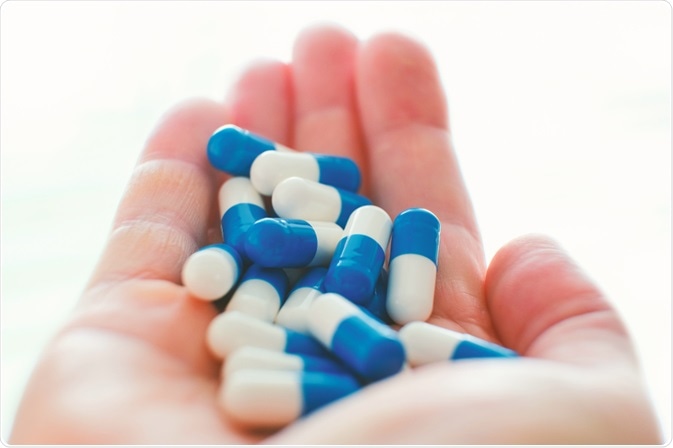In drug discovery, various parameters need to be established in preclinical trials before a pharmaceutical is approved for initial testing on human subjects. Pharmacokinetics is a field of study which helps scientists understand how a molecule behaves once in the body.
 Image Credit: Andrey Mihaylov / Shutterstock.com
Image Credit: Andrey Mihaylov / Shutterstock.com
Pharmacokinetics - an overview
Sometimes referred to as PK, pharmacokinetics is a branch of pharmacology that is dedicated to determining the fate of substances administered to a living organism. Chemical xenobiotics such as drugs, food additives, pesticides, and cosmetics are all investigated by PK studies.
It’s not just how a molecule acts within the organism that determines its fate from initial administration to complete elimination, however. The organism itself acts upon an introduced chemical substance due to a number of factors. Pharmacokinetics is the study of how the organism affects the substance, compared to how the molecule affects the organism.
Pharmacodynamics (PD) is the study of how the molecule affects the organism. Both PK and PD are combined in PK/PD models, which influence the dosing, benefit, and adverse effects of administered substances. There are several different pharmacokinetic models used which try to understand how a molecule behaves in and affects an organism. The multi-compartmental model is a commonly used mathematical standard.
Factors and metrics
Common metrics measured by PK methods include dose, dosing interval, bioavailability, volume of distribution, concentration, absorption half-life, elimination rate constant, and infusion rate. Many factors influence these metrics, including the action of enzymes in metabolizing the substance, as well as genetic makeup, sex, and age.
For example, the half-life of some drugs can be longer in older people. Physiological changes which occur with aging affect many aspects of pharmacokinetics. Other factors relate to individual physiology, such as renal failure and obesity.
Drug administration must be based upon each individual patient’s needs, which can delay optimal response or result in adverse effects. Pharmacokinetic principles help doctors adjust dosage more accurately and rapidly.
Why pharmacokinetics is important for preclinical trials
Knowledge of how a molecule behaves informs the suitability of it as a drug target. Without this knowledge, a drug developed containing the substance may cause death or adverse side-effects. It may cause cancer or genotoxic effects. This is obviously detrimental and should be avoided.
Pharmacokinetics, along with pharmacodynamics, provides accurate data for the preclinical trial which then informs the related clinical trial. Thus, initial dosages can be accurately measured, and potential side-effects can be managed. Animal models are always used before human trials can be authorized.
Some of the most important pharmacokinetic principles that must be understood during pre-clinical testing are distribution, absorption, metabolism, and excretion. Before human clinical trials can proceed, in-vitro biochemical data regarding the drug reactions need to be reported and analyzed.
Pharmacokinetic models, if implemented and analyzed correctly, can help to ensure that drugs do not fail during trials due to reasons that could have both been predicted and avoided. This is advantageous in a manner of ways. Not only is there a human health consideration, it also has financial implications for trials.
Pharmacokinetic models have been used as a standard for decades, informing most clinical trials by providing accurate data on the predicted behavior of target drugs and molecules. Apart from drug discovery, pharmacokinetic models can inform a wide array of other research.
Pharmacokinetics - Part 1: Topical and Systemic Drugs
The route to drug addiction: why pharmacokinetic studies matter
Narcotic consumption can lead to addiction in some individuals. How the casual or recreational patterns of drug use cause the problematic patterns of use that are indicative of addiction are of particular concern to scientists working in addiction research.
In most preclinical studies, self-administration is the main model of these patterns. There is one main issue with this approach, however. Self-administration involves consistently high levels of the drug, whereas in real-life situations, drug use is more intermittent.
Models of a molecule’s temporal pharmacokinetic factors are important in elucidating why intermittent consumption leads to profound levels of cocaine addiction, for example. Traditional self-administration approaches may give inaccurate data. A 2019 study published in Psychopharmacology used pharmacokinetic principles to explore this question in cocaine addiction.
Led by Alex B. Kawa, the results of the study found that the temporal pattern of cocaine use had profound effects. Intermittent access to the drug was found to be much more effective at producing addiction-like behaviors. Secondly, intermittent and long access self-administration influences motivated behavior in different ways by changing the brain in different manners.
The team proposed, using pharmacokinetic principles as the basis of their proposal, that intermittent access self-administration procedures might be more effective in preclinical trials which seek to provide data on addiction patterns.
In conclusion
Pharmacokinetics is an important field of study which provides important data on the behavior of molecules within organisms. By applying pharmacokinetic principles to preclinical trials, safer and more accurate clinical trials can be designed by scientists.
Further Reading